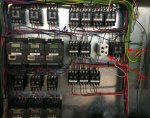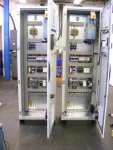horrorsix
Member
- Location
- Harrisburg PA

Attached is a picture of a motor start control assembly that we built. This is for a large conveyor system. The owner opted ,for some reason, NOT to go with the company who designed the conveyor system and get the factory built PLC control unit. Motor controls are not my specialty but these are long time customers of mine and they asked us to build this old school with contactors. On paper this should work but we're having a problem. I'll explain the problem and then how we have it wired. If anyone has any feedback that would be great.
Problem: Various contractors intermittently are not pulling in far enough and humming like hell. Not one contactor is consistently failing. It's like the all the coils are not getting enough power. Sometimes they work sometimes they don't.
Wiring: There are 15 motor control contactors. All coils are wired from the same 20A/120V circuit. All contactors are 25A 3 pole and all are wired in parallel.. There is a delay relay that turns the signal on for 5 sec. then turns all the motor start contactors on. The contactor in the picture labeled the power start is the first contactor where the emergency stops are wired through. Right now the emergency stops are jumped out and there is no power to the motors. The only thing powered are the coils. We were just testing the contactors for their operation. All contactors are engaging and the delay relay is turning the signal on and off but the the contactors are not all pulling in all the way. You can physically push them in and get them to quiet up.
Coil voltage is 122V and amp draw is .8A
Is there something I have wired wrong?

